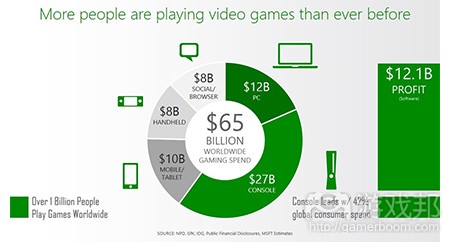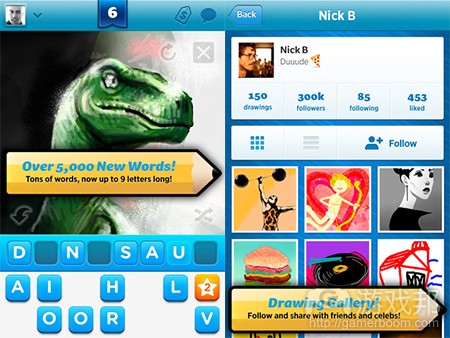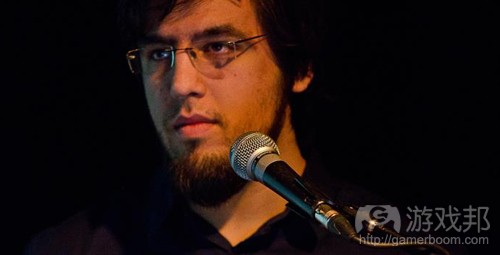每日观察:关注Google Play应用检索数据和相关建议(5.21)
1)微软最近数据显示,手机和平板电脑游戏在游戏行业年收益中已占比超过15%,智能手机及平板电脑游戏一年创收已达100亿美元,超过了掌机和社交游戏收益(这两者分别是80亿美元)。
尽管移动游戏发展迅猛,但“第七代”主机(包括Xbox 360、PS3和Wii)在2009年安装量达到3亿,比上一代主机增长了50%;主机游戏年收益仍达到270亿美元,在全球用户投入中占比42%;PC游戏则是120亿美元。
总体上看,所有平台的游戏年收益达650亿美元。
2)BTIG调查结果显示,Zynga4月底发布的手机游戏《Draw Something》上线之初表现强劲,发布头两天在iOS下载榜单位居榜首,但仅维持1周就在5月2日降至第二名,并且仅保持了3天。
在5月5日之后,该游戏骤降至第31名。
原版《Draw Something》由OMGPOP发布于2012年2月1日,并在3月3日上升至榜单第一位,在4月4日前一直移居榜单首位。但Zynga收购OMGPOP之后,该游戏在5月24日(与初次上线时相隔了3个月)降至第26名。
从收益榜单来看,《Draw Something 2》表现更不理想,原版游戏在2012年3月21日在收益榜单排名第三,两个月之后降至第70名上下;而《Draw Something 2》最高峰时也仅位居第74名,目前已降至第151名。
3)据pocketgamer报道,Google高管Ankit Jain在最近的Google I/O大会上分享了开发者提高应用在Google Play曝光度的建议,指出应用名称是检索过程中最重要的元数据。
除了名称之外,开发者还应该在应用描述的第一句话中说明应用的主要内容,以便用户更快捷地检索到应用,另外最好在应用描述中添加图片和视频。
Jain还指出,目前每天有12%的Google Play日活跃用户(DAU)检索应用,50%的DAU每周都会检索应用。Google Play一个月会产生600万个独立检索字段。
他还建议开发者的产品名称不要使用现有热门应用名称的变体,最好选择一些容易拼写的字段,以防用户在检索时拼写错误。他还指出在Google Play每月的600万独立检索字段中,有50%的查询内容存在拼写错误的问题。
4)据gamasutra报道,荷兰独立工作室Vlambeer联合创始人Rami Ismail在最近采访中表示,他认为开发者有许多植入免费模式的手段,但多数方式却有损核心游戏设计。
他称邪恶的IAP等技巧会削弱游戏的核心设计,多数成功的免费游戏十分擅长剥削玩家,而尝试使用好方法植入免费模式的游戏几乎都遭遇了运营上的失败。
Ismail强调IAP本身并不会导致恶劣的游戏设计,但其植入方式却表明“尽管剥削用户就是最有效的IAP执行方法”。他认为当前App Store中的许多游戏都不是好游戏,只是偶然赚取大量收益获得了许多曝光度,它们是免费产品,主要围绕让用户上瘾和花钱的理念而设计。
5)据gamasutra报道,日本移动游戏公司GREE在公布2013财年第三季度的“额外亏损”之后,被迫关闭位于中国北京的工作室,以便提高其整体开发系统的效率。
以此同时,GREE还发现公司在日本的虚拟货币消费额也未能达标,因此预计整个2013财年公司在日本社交游戏业务销售额将无法达到之前的预期。
截止2013年3月31日,GREE在该季度收益为379亿日元(3.694亿美元),同比上年下降18%,利润为47亿日元(4600万美元),同比上年下降65%。
针对整个2013财年,GREE预计全年收益将达1500亿日元(15亿美元),比之前预期下降9%;利润为240亿日元(2.344亿美元),比之前预期下降28%。(本文为游戏邦/gamerboom.com编译,拒绝任何不保留版权的转载,如需转载请联系:游戏邦)
1)Microsoft: Mobile and tablets generate 15% of games revenue
by Keith Andrew
Consoles remain the dominant force when it comes to games revenue, but the mobile and tablet sector is catching up fast, accounting for more than 15 percent of annual gaming revenue.
That’s according to numbers published by Microsoft, which suggest that games across smartphones and slates generate $10 billion a year.
Importantly, that’s more money than both the handheld and social gaming sectors generate.
On the up
The figures, which are based on numbers sourced from numerous bodies such as NPD, Gfk IDG as well as Microsoft’s own estimates, suggest that more people are playing games than ever in the industry’s history.
Indeed, despite the rise of mobile, Microsoft claims that the ‘seventh generation’ of consoles – Xbox 360, PS3 and Wii – actually represented a peak for home systems, with an install base of 300 million back in 2009, up 50 percent on the previous generation.
In all, games across all platforms generate $65 billion a year.(source:pocketgamer)
2)Drawing a blank: Draw Something 2 struggling to monetise, says BTIG Research
by Matthew Diener
Zynga’s acquisition of OMGPOP is failing to deliver the goods, with the studio’s Draw Something follow up falling short of the success enjoyed by its predecessor.
That’s according to research carried about by BTIG, which concludes that the strong debut of Draw Something 2 back at the end of April has been followed by a strong decline in the game’s
fortunes.
In short, Zynga is struggling to recapture the appeal – and, more importantly, earning potential – of the original game.
Draw Something… anything
That’s a trend that won’t surprise everyone, however.
The original Draw Something’s popularity began to wane shortly after Zynga acquired OMGPOP – a decision that ultimately led to the social gaming giant writing off close to $95 million in revenue in 2012.
Nevertheless, Draw Something 2′s start looked promising. The app reached the coveted #1 spot in iOS downloads within two days of its release.
As BTIG’s analysis highlights, the game only lingered there for a week, however, before falling to the #2 spot on 2 May that it held onto for three days.
After 5 May, Draw Something 2 plummeted down to the #31 spot all less than a month after its release.
Fudged follow up?
For comparison’s sake, the original Draw Something was released by OMGPOP on February 1, 2012 and reached #1 on March 3 2012.
It hovered around the top spot until 4 April (two weeks after the Zynga acquisition) and fell to the #26 spot on 24 May, nearly three months after it peaked at #1.
In terms of grossing ranks, the picture for Draw Something 2 is even bleaker. The original Draw Something peaked at #3 on March 21 2012 before falling down to the mid-70s two months later.
Draw Something 2, by contrast, peaked at #74 on the grossing ranks and has since declined to #151, painting a picture of a game that – to Zynga’s cost – isn’t monetising as the firm would hope.(source:pocketgamer)
3)Think creatively: 50% of 6 million monthly Google Play search terms are misspelled
by Matthew Diener
Because many apps live and die based on discovery, developers are understandably curious about how iOS and Google Play searches actually work.
Google took some time during its I/O event in San Francisco to talk frankly about search on Google Play.
Starting from the top down, Google’s Ankit Jain noted that “it’s important to be creative as well as detailed” with an app’s title as the title is the most important piece of metadata that will lead a search to an app.
Lost and found
Once the title is sorted, Jain recommends that the first sentence of an app’s description should tell a user what to expect from an app.
Encouraging developers to think as users, Jain stresses “Right up front, make sure your user knows what your app is about”.
After this, it’s recommended to include pictures and video – but being direct and descriptive early on will lead to easier discovery.
Jain also disclosed some figures about Google Play searches, noting that 12 percent of daily active users search for app every day while 50 percent of DAUs search weekly.
In a given month, Google Play sees six million unique phrases searched for.
So what can you do to maximize your chances of app discovery? Jain provides five quick tips.
•Designed for tablets: Jain highly recommends that developers with a tablet app get the “designed for tablets” designation, which was announced as a new feature for the Google Play Store at
I/O.
•Ensure helpful anchor text: most articles from news outlets don’t use a helpful anchor text that links to an app. He recommends developers work with writers to write something “interesting” in these links.
•Avoid common mistakes: don’t choose an app name that’s a variant of an existing popular app. Also, pick something that’s easy to spell. Jain noted that of the six million unique phrases searched monthly, 50 percent of the queries are misspelled.
•Make your Android application package (APK) smaller: Smaller APKs get installed more frequently.
•Create the viral loop for your app: A. Get users to review your apps. B. Don’t get users to leave your app. This can be accomplished by adding an in-app Google+ +1 API, and in the future,
Google will release an API for in-app user reviews. C. Integrate Google Play’s newly launched game services.(source:pocketgamer)
4)Can free-to-play be effective without being exploitative?
By Mike Rose
“There are lots of ways to implement free-to-play, and most of them are detrimental to the core game design.”
- Rami Ismail, one half of Dutch indie studio Vlambeer, discusses why he still isn’t a fan of the free-to-play space.
Ismail has spoken out before about “evil in-app purchase stuff,” stating that these monetization techniques more often than not take away from a game’s core design.
Talking to free-to-play consultant Will Luton, and as reported by PocketGamer.biz, Ismail reiterated his thoughts, noting that the most successful free-to-play titles are those that exploit players.
“The problem we see is that, the way to efficiently do free-to-play is to exploit people, or to exploit the psychology of people in a way that is often perpendicular or opposite to core game design,” he says.
“That is something we worry about because we see potential in implementing free-to-play in a good way,” he adds, “but every game we’ve seen that tries to do that has been a financial failure.”
Ismail is keen to stress that in-app purchases in a game do not automatically lead to bad game design, but he says that “the solutions that are being implemented at this point show really clearly that the most efficient way to do in-app purchases is exploiting people as much as possible.”
He concludes, “A lot of games currently in the App Store are not necessarily good games, and just happen to gross a lot because they get a lot of attention, they’re free, people can play them, and they’re built in such a way that they get people addicted and spending money.”(source:gamasutra)
5)Gree closes Chinese studio as profits dip
By Mike Rose
Japanese mobile company Gree has been forced to close its studio in China, after recording “extraordinary loss” as a result of its recent business performance in its full 2013 fiscal forecast.
As part of Gree’s third quarter results, the company noted that it has recorded “a one-time write-off of assets related to certain titles.” These costs are associated with the company’s new game selection strategy.
Although the company did not specify which titles it was referring to, it did note that it is closing its Beijing studio to increase the efficiency of its overall development system.
Meanwhile, Gree is finding that virtual currency consumption in Japan is falling short of targets. For this reason, the company believes that its Japanese social games will not generate the previously expected sales.
But it’s not all bad news. Gree is finding that overseas virtual currency consumption is strong, especially in titles like Crime City and Modern War.
Gree says it is hoping to quell this recent downward profits shift by focusing on releasing top-quality mobile games, and building on the current momentum of its U.S. studio — although this seems to clash with the fact that the company just laid off workers at this studio.
For the quarter ended March 31, 2013, Gree recorded revenues of 37.9 billion yen ($369.4 million), down 18 percent year-over-year, and profits of 4.7 billion yen ($46.0 million), down 65 percent year-over-year.
As for the revised full-year forecast, Gree now estimates revenues of 150 billion yen ($1.5 billion), down around 9 percent on its original forecast, and profits of 24 billion yen ($234.4 million), down around 28 percent on its original forecast.(source:gamasutra)











































 闽公网安备35020302001549号
闽公网安备35020302001549号